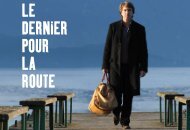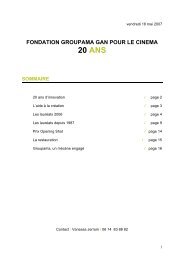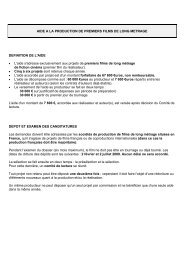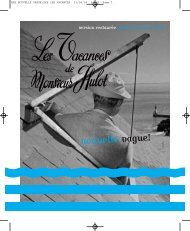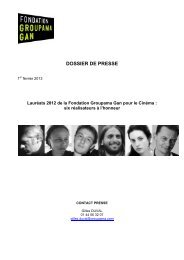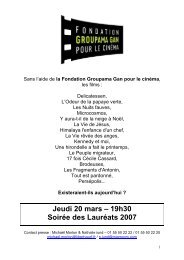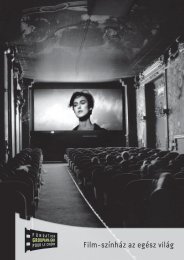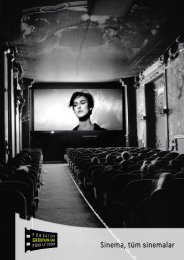Dossier de presse « Lola - Ciné-Tamaris
Dossier de presse « Lola - Ciné-Tamaris
Dossier de presse « Lola - Ciné-Tamaris
Create successful ePaper yourself
Turn your PDF publications into a flip-book with our unique Google optimized e-Paper software.
the RESToRATION<br />
Research followed by reconstruction,<br />
to keep the director’s intentions intact<br />
We carried out a certain amount of research about the<br />
film. We researched the archive elements assembled by<br />
Ciné-<strong>Tamaris</strong> and Jacques’ family. Next, we began the<br />
reconstruction process that would allow us to piece the<br />
film and the director’s intentions back together. It was<br />
more a matter of reconstituting the story of this film<br />
and evoking an artistic work than of simply eliminating<br />
small scratches and dust.<br />
Digitisation, selection and fusion<br />
The next phase consists of digitising, ie digitally recording<br />
the elements that are available to us, whatever<br />
they may be, and transforming them into high-resolution<br />
data. In the case of <strong>Lola</strong>, we had two elements to<br />
work with: an old internegative and a more recent one,<br />
which had been restored photochemically. These provi<strong>de</strong>d<br />
us with tens, hundreds, or even thousands of images<br />
for each element… We scanned both of these internegatives,<br />
and then we compared the result frame by frame,<br />
allowing us to make an optimal selection in or<strong>de</strong>r to<br />
compose a single element.<br />
We scanned the film with the aid of an ultra sophisticated<br />
machine nicknamed “Scanity”. It is specially<br />
<strong>de</strong>signed to manipulate film that has become fragile over<br />
time and there’s nothing aggressive about its mechanisms:<br />
it uses an electronic recording system, there are<br />
no little notches to hold the film in place, the machine<br />
unwinds the film with extreme care. From this, we obtained<br />
a magnificent picture, a scanned master in very<br />
high resolution. Basically, we merged the two versions<br />
and reconstituted a new chain of images, thanks to<br />
these digitised resources.<br />
Frame by frame<br />
Once the images have been sorted and assembled, we can<br />
send them out to several teams at once. We can tackle all<br />
of the problems relating to <strong>de</strong>gradation, frame by frame,<br />
and in particular, issues of stability and trembling images.<br />
Sometimes, this can be repaired, but not always.<br />
Calibration and realignment<br />
The color gra<strong>de</strong>r projects the film onto an immense movie<br />
screen, simulating real conditions, and realigns shot by<br />
shot, frame by frame, in or<strong>de</strong>r to obtain the highest visual<br />
quality possible. We ma<strong>de</strong> a series of <strong>de</strong>cisions with<br />
respect to the <strong>de</strong>nsity, luminosity and overall aesthetic<br />
of the image. When directors are still alive, we can<br />
ask them what their intentions were. Unfortunately,<br />
most of the time that’s not possible. In the case of <strong>Lola</strong>,<br />
we worked closely with Jacques Demy’s son, Mathieu<br />
Demy. He supervised the calibration of whites, blacks<br />
and greys, frame by frame… Our goal is to recreate the<br />
photography as the director and the cameraman had<br />
originally inten<strong>de</strong>d it to be. Next, we go into the editing<br />
room to repair, with extreme precision, all of the technical<br />
problems encountered during the re-editing of the<br />
film, where the images have been cut or have simply<br />
disappeared. All of these phases take place in<strong>de</strong>pen<strong>de</strong>ntly<br />
of one another.<br />
Then there’s the sound…<br />
Finally, we simultaneously restored the film’s soundtrack.<br />
In the case of <strong>Lola</strong>, the original elements had been lost<br />
and the only existing audio track was the optical sound<br />
of the copy that had allowed a new internegative to be<br />
printed. It wasn’t really an i<strong>de</strong>al source to work from,<br />
but it’s all we had, so we had to get the best out of it<br />
that we could. In or<strong>de</strong>r to restore the soundtrack, we<br />
digitise the audio track, meaning that we extract the<br />
physical element and transform it into data, then the<br />
restoration team strives to optimise the quality, removing<br />
any hissing, crackling, small clicks and all kinds<br />
of sound pollution that interferes with the sound. The<br />
technicians try to realign it – for <strong>Lola</strong>, it was a mono track<br />
– and obtain the best sound quality possible based on<br />
this element.<br />
Sound and image finally reunited<br />
Each unit works separately to provi<strong>de</strong> their own piece<br />
of the puzzle. Then we merge it all together, assembling<br />
all of the new and repaired elements, and we obtain an<br />
image and sound of much higher quality than before.<br />
Constant doubts<br />
Important questions always arise when restoring a damaged<br />
film. We are faced with drastic choices. We are very<br />
careful not to cross the line between what may affect the<br />
aesthetic of the film or run counter to the technological<br />
possibilities of its era. For instance: fa<strong>de</strong>s. The means<br />
for producing a fa<strong>de</strong> in Jacques Demy’s time were not<br />
as sophisticated as they are today. The real question<br />
is that of knowing whether we are improving things<br />
simply because we can, or whether we should focus on<br />
other problems by choosing to allow the patina of time<br />
to show through. In our case, the general ten<strong>de</strong>ncy is<br />
often to leave things as they are.<br />
We must not leave the slightest trace. When the job<br />
has been done right, no one should know that we were<br />
there. It is essential to bear this in mind when we are<br />
confronted with a dilemma, since our natural ten<strong>de</strong>ncy<br />
is to want to adapt things to the new criteria. We are<br />
so used to seeing digital images shot in very high resolution<br />
that are incredibly pure, without grain, dust, parasites,<br />
trembling or instability, that we are tempted to<br />
reproduce the same thing, as though the film had been<br />
shot yesterday. But that is not our goal. The goal is to<br />
allow the film to have exactly the same aesthetic as<br />
the one it had when it was completed in the sixties.<br />
This is what we are striving for, and it’s a relentless<br />
challenge.<br />
BIOGRAPHIES<br />
JACQUES DEMY<br />
Born on 5 June 1931 in Pontchâteau (Loire Atlantique), Jacques Demy spent his childhood in Nantes in his father’s<br />
garage. Bombing of Nantes in 1944. Technical high school and animated film experiments from the age of 14. In Paris, he<br />
atten<strong>de</strong>d the École <strong>de</strong> Vaugirard (direction and cinematography). After having assisted Paul Grimaud for publicity spots<br />
and Georges Rouquier for two films, Jacques ma<strong>de</strong> his first short film at the age of 24, Le Sabotier du Val <strong>de</strong> Loire (1955).<br />
Feature films that he wrote and directed were to follow.<br />
Some have remained treasures of New Wave cinema:<br />
- <strong>Lola</strong> (1961), which marked the start of his collaboration with Michel Legrand<br />
- Bay of Angels (1963),<br />
- The Umbrellas of Cherbourg (1964) (Palme d’Or at the Festival <strong>de</strong> Cannes, Prix Louis Delluc, nomination at the Oscars)<br />
- The Young Girls of Rochefort (1967)<br />
- Donkey Skin (1970)<br />
Jacques also ma<strong>de</strong> films in English:<br />
- Mo<strong>de</strong>l Shop (1968)<br />
- The Pied Piper (1972)<br />
- Lady Oscar (1978)<br />
Among his other films; Une Chambre en Ville (1982), a film that is entirely sung, like The Umbrellas of Cherbourg, but this<br />
time, the composer was Michel Colombier.<br />
Demy’s last film, shot in 1988, was a musical (Yves Montand’s first): Three Seats for the 26th (1988).<br />
Music by Michel Legrand.<br />
In it, we hear: “Dancing movie, singing movie,<br />
Cinema, your cheerfulness enchants me,<br />
Laughing movie, happy movie,<br />
Cynical movie, mocking movie,<br />
violent movie for the rowdy,<br />
those movies are all the same to me,<br />
What I prefer is musical comedy!”<br />
Jacques Demy met Agnès Varda in 1958. They raised Rosalie and Mathieu.<br />
Rosalie, a costume <strong>de</strong>signer, worked with her father on four of his films.<br />
Mathieu, born in 1972, is an actor and film director.<br />
Jacques Demy died on the 27th of October 1990.<br />
Most of his films were restored by Ciné-<strong>Tamaris</strong> un<strong>de</strong>r the attentive care of Agnès and their children.<br />
The market square opposite the Mairie of the XIVth arrondissement in Paris was named Place Jacques Demy.<br />
The exhibition JACQUES DEMY, produced by the Cinémathèque Française in association with Ciné-<strong>Tamaris</strong>,<br />
will take place from 10 April to 4 August 2013, at the Cinémathèque Française<br />
and will be accompanied by a retrospective of all his films, digitized and restored.<br />
72 I LOLA LOLA I 73<br />
Short Films:<br />
1955 LE SABOTIER DU VAL DE LOIRE<br />
1957 LE BEL INDIFFÉRENT<br />
1958 LA MÈRE ET L’ENFANT<br />
1959 ARS<br />
1961 LA LUXURE<br />
Feature films:<br />
1961 LOLA<br />
1963 LA BAIE DES ANGES<br />
1964 LES PARAPLUIES DE CHERBOURG<br />
1967 LES DEMOISELLES DE ROCHEFORT<br />
1968 MODEL SHOP<br />
1970 PEAU D’ÂNE<br />
1972 THE PIED PIPER OF HAMELIN ( LE JOUEUR DE FLÛTE )<br />
1973 L’ÉVÈNEMENT LE PLUS IMPORTANT<br />
DEPUIS QUE L’HOMME A MARCHÉ SUR LA LUNE<br />
1978 LADY OSCAR<br />
1980 LA NAISSANCE DU JOUR<br />
1982 UNE CHAMBRE EN VILLE<br />
1985 PARKING<br />
1988 TROIS PLACES POUR LE 26



